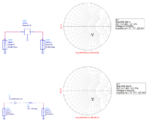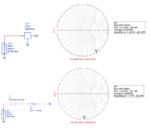seackone
Junior Member level 1

Hi,
I measured a voltage controlled capacitor with a network analyzer (NWA) in series-through configuration. That means: Port 1 of the NWA is connected with RF input of the capacitor, Port 2 accordingly with the output. For every capacitor bias voltage (1 V to 24 V with 0.1 V steps), i've got one 2 Port s-parameter file.
After that, I want to implement these files in Keysight's "Advanced Design System" (ADS) to calculate the capacity over bias voltage for different frequencies. There is no problem with a 50 ohm term element at the start and the end of the s-parameter container (which contains the measured s-parameter files) and a simple s-parameter simulation. Thats configuration is equal to the measurement with the NWA.
Now, I want to simulate the capacitor in shunt configuration (RF input with 50 ohm term element, output connected to ground). Is there any possibility to use my series-through s-parameter measurement (50 Ohm at the two ports) for the shunt simulation without measuring the capacitor again? Maybe with an equivalent subcircuit or something else?
Thank you for your ideas.
Best regards.
I measured a voltage controlled capacitor with a network analyzer (NWA) in series-through configuration. That means: Port 1 of the NWA is connected with RF input of the capacitor, Port 2 accordingly with the output. For every capacitor bias voltage (1 V to 24 V with 0.1 V steps), i've got one 2 Port s-parameter file.
After that, I want to implement these files in Keysight's "Advanced Design System" (ADS) to calculate the capacity over bias voltage for different frequencies. There is no problem with a 50 ohm term element at the start and the end of the s-parameter container (which contains the measured s-parameter files) and a simple s-parameter simulation. Thats configuration is equal to the measurement with the NWA.
Now, I want to simulate the capacitor in shunt configuration (RF input with 50 ohm term element, output connected to ground). Is there any possibility to use my series-through s-parameter measurement (50 Ohm at the two ports) for the shunt simulation without measuring the capacitor again? Maybe with an equivalent subcircuit or something else?
Thank you for your ideas.
Best regards.




